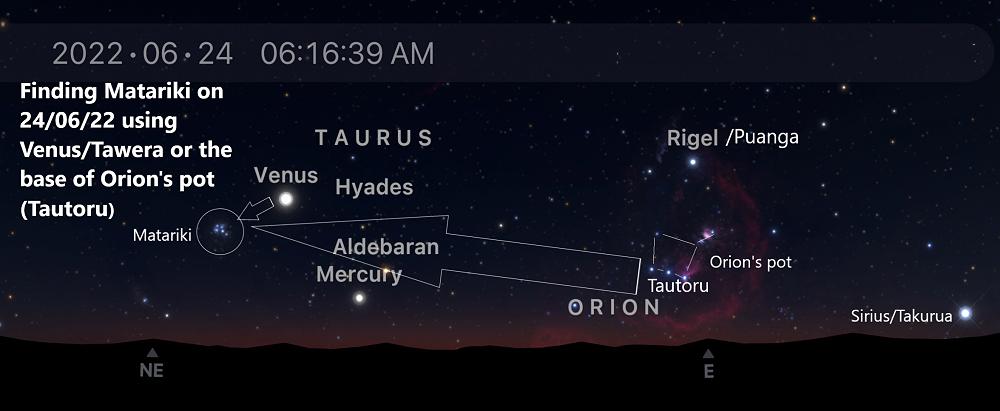
Matariki "ABC"
Claire Ryan offers three areas for celebrating the appearance of Matariki in our early morning sky.
Ngā mihi o Matariki! (Happy Matariki)! So, another holiday! What does it mean, and how can we celebrate it? As an amateur astronomer who has lived in this nation for most of my life, I offer a few suggestions — not as the definitive answer because I have no right to claim that — but as a way to start some dialogue. Here are my thoughts on Matariki "ABC"— astronomy, biculturalism and community.
Astronomy
Matariki is a small cluster of stars, visible all over the world except from Antarctica, but it is virtually impossible to see in very southern latitudes, because it is very low in the sky there and hidden by hills and homes. It is the most obvious and famous of about 1,100 “open clusters” (stars held loosely together by a gravitational bond). The cluster is known also as the Pleiades or the Seven Sisters, Subaru (Japanese), Makali’i (Hawaiian), Matali’i (Samoan), and Matari’i (Tahitian) .
Sharp eyes can see six or seven stars in the cluster but there are about 3,000. Binoculars are a great way to see them but the powerful magnitude of a telescope splits them too far apart. Many of the stars in Matariki are bluish, hot, young stars — only about 100 million years old! The glow or haze around them is a dust cloud through which they are passing.
These stars are about 444 light years away. The light we see from Matariki this June started on its way to us while Elizabeth I sat on the English throne. A light year is the distance a beam of light travels in one year — 9 trillion kilometres. The mathematicians among us will have already worked out that Matariki is therefore just under 4 quadrillion kilometres away. The mechanics among us will have already worked out that if we set off for Matariki in a car at 100 kmph, it would take us almost 5 billion years.
Back down on Earth, Matariki has been used for centuries as a navigational guide. Tohunga kōkōrangi or expert astronomers used these stars to help them travel across the Pacific. Aotearoa New Zealand has a proud history of contributions to navigation, astronomy and rocketry. Our Matariki holiday is a time to acknowledge this, to celebrate science, to look up and smile!
Biculturalism
It is also a time to acknowledge te Tiriti between tangata whenua and manuhiri and what we can learn from each other. Matariki is the name given to the cluster above this land by its people, who have for centuries planted crops, caught fish and charted life by the calendar known as Maramataka or the turning of the moon. Their traditional culture, fused with astronomical observation, calendrical knowledge and the delineation of seasons, has been passed down and retained first by oral tradition then transcription. We can learn a great deal from it.
“Matariki” means “eyes of god” and may refer to the pūrakau or story of Tāwhirimātea, the god of wind and weather, who when he discovered that his siblings had separated his parents Ranginui and Papatūānuku, tore out his eyes and threw them in rage into the sky, landing on=his father’s chest, where they remain, preserved and protected forever. Another pūrakau is that the brightest star in the cluster is the whaea or mother, surrounded by her family.
As agriculturalists, Māori have planned their years by the rising of stars in the morning. The “heliacal rising” (meaning “becoming visible just before sunrise”) of Matariki heralds the New Year, just as it does in cultures across the southern hemisphere, as the time when the short wintry days will start to become longer. Not all iwi celebrate at the same time, some beginning on the first new moon or full moon after Matariki rises and some celebrating Puanga (the star Rigel in the constellation Orion) where that star is more visible than Matariki.
In the northern hemisphere, New Year comes six months later, which of course is winter there. Marking Matariki allows us to recapture and celebrate a New Year consistent with our seasons and is a time to learn about Maramataka and the kaupapa of the sky above us.
Community
Matariki has historically been and now is again, a time for celebration, growth and renewal, a time to gather, to reflect on the past, acknowledge the present and plan for the year ahead. We mourn for those who have passed and rejoice with the living. It represents a synthesis of science and spirituality, challenge and comfort, death and life. The old whakataukī or proverb “Matariki
ahunga nui” (the great mounds of Matariki) refers to such food as kumara which has been stored before the frosts and is now shared.
However, the great mounds are not always full these days. Our homeless are cold and hungry. Winter rains bring regular floods to lands where flooding was once rare. Our safe pre-COVID world has been shattered. It is hard for many to put food on the table. There is an increase not just in petrol prices but in war.
Matariki is a time for us to do more than mouth platitudes but to feed hungry mouths and heed mouths calling for justice. The wero to those of us who have storehouses is to open them and share, whether our kumara be psychological, physical, spiritual or a combination of these. Of course we cannot do it alone. The God of Amos 5:8, Job 9:9 and 38:31 is with us as are those we love. Kua haehae ngā hihi o Matariki (the rays of Matariki are spread.) Let us spread those rays this winter. Happy Matariki to you all.
Tui Motu Magazine. Issue 271 June 2022: 10-11
